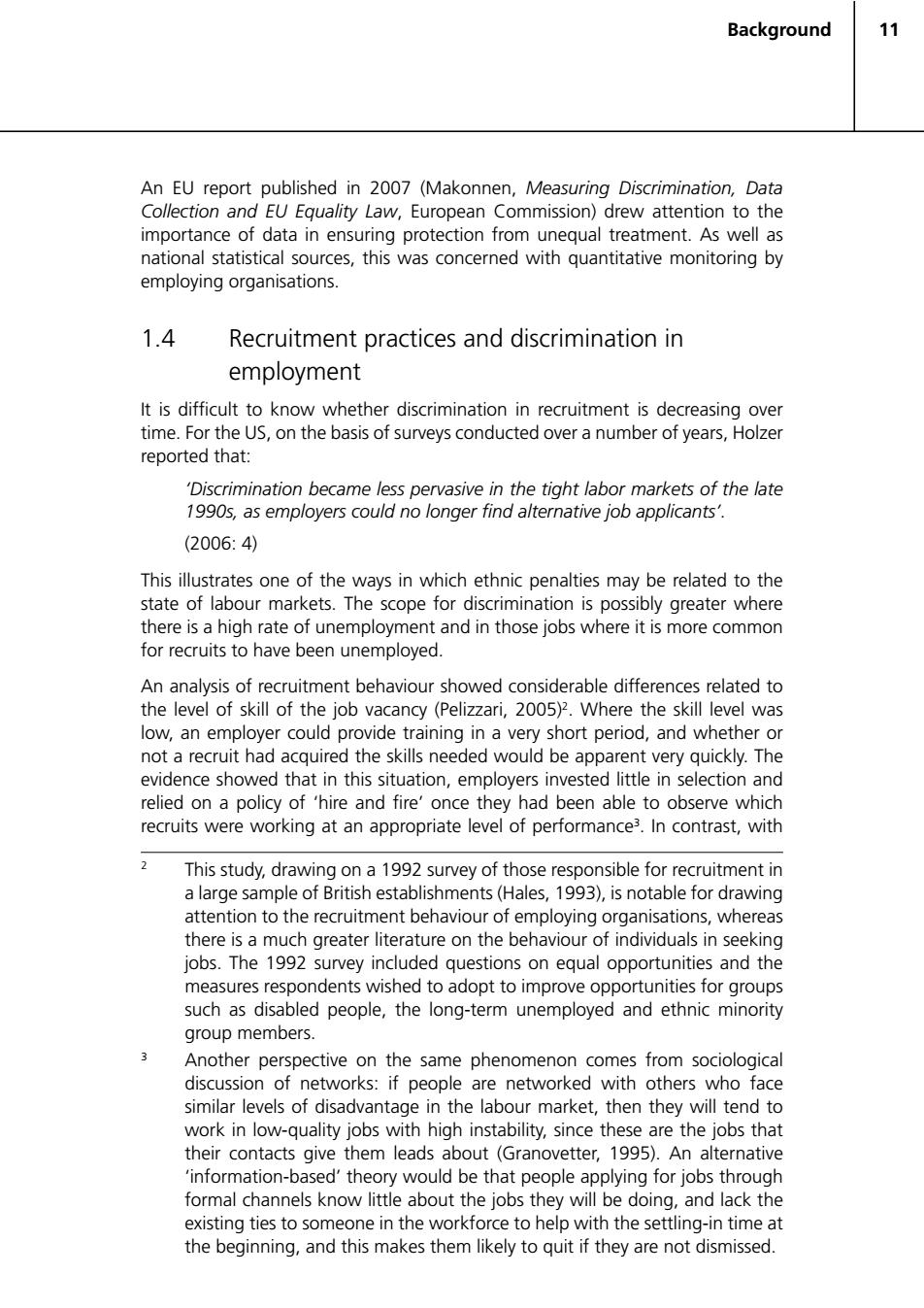正在加载图片...

Background 11 An EU report published in 2007(Makonnen,Measuring Discrimination,Data Collection and EU Equality Law,European Commission)drew attention to the importance of data in ensuring protection from unequal treatment.As well as national statistical sources,this was concerned with quantitative monitoring by employing organisations. 1.4 Recruitment practices and discrimination in employment It is difficult to know whether discrimination in recruitment is decreasing over time.For the US,on the basis of surveys conducted over a number of years,Holzer reported that: 'Discrimination became less pervasive in the tight labor markets of the late 1990s,as employers could no longer find alternative job applicants'. (2006:4) This illustrates one of the ways in which ethnic penalties may be related to the state of labour markets.The scope for discrimination is possibly greater where there is a high rate of unemployment and in those jobs where it is more common for recruits to have been unemployed. An analysis of recruitment behaviour showed considerable differences related to the level of skill of the job vacancy (Pelizzari,2005)2.Where the skill level was low,an employer could provide training in a very short period,and whether or not a recruit had acquired the skills needed would be apparent very quickly.The evidence showed that in this situation,employers invested little in selection and relied on a policy of 'hire and fire'once they had been able to observe which recruits were working at an appropriate level of performance3.In contrast,with This study,drawing on a 1992 survey of those responsible for recruitment in a large sample of British establishments(Hales,1993),is notable for drawing attention to the recruitment behaviour of employing organisations,whereas there is a much greater literature on the behaviour of individuals in seeking jobs.The 1992 survey included questions on equal opportunities and the measures respondents wished to adopt to improve opportunities for groups such as disabled people,the long-term unemployed and ethnic minority group members. Another perspective on the same phenomenon comes from sociological discussion of networks:if people are networked with others who face similar levels of disadvantage in the labour market,then they will tend to work in low-quality jobs with high instability,since these are the jobs that their contacts give them leads about (Granovetter,1995).An alternative 'information-based'theory would be that people applying for jobs through formal channels know little about the jobs they will be doing,and lack the existing ties to someone in the workforce to help with the settling-in time at the beginning,and this makes them likely to quit if they are not dismissed.11 An EU report published in 2007 (Makonnen, Measuring Discrimination, Data Collection and EU Equality Law, European Commission) drew attention to the importance of data in ensuring protection from unequal treatment. As well as national statistical sources, this was concerned with quantitative monitoring by employing organisations. 1.4 Recruitment practices and discrimination in employment It is difficult to know whether discrimination in recruitment is decreasing over time. For the US, on the basis of surveys conducted over a number of years, Holzer reported that: ‘Discrimination became less pervasive in the tight labor markets of the late 1990s, as employers could no longer find alternative job applicants’. (2006: 4) This illustrates one of the ways in which ethnic penalties may be related to the state of labour markets. The scope for discrimination is possibly greater where there is a high rate of unemployment and in those jobs where it is more common for recruits to have been unemployed. An analysis of recruitment behaviour showed considerable differences related to the level of skill of the job vacancy (Pelizzari, 2005)2 . Where the skill level was low, an employer could provide training in a very short period, and whether or not a recruit had acquired the skills needed would be apparent very quickly. The evidence showed that in this situation, employers invested little in selection and relied on a policy of ‘hire and fire’ once they had been able to observe which recruits were working at an appropriate level of performance3 . In contrast, with 2 This study, drawing on a 1992 survey of those responsible for recruitment in a large sample of British establishments (Hales, 1993), is notable for drawing attention to the recruitment behaviour of employing organisations, whereas there is a much greater literature on the behaviour of individuals in seeking jobs. The 1992 survey included questions on equal opportunities and the measures respondents wished to adopt to improve opportunities for groups such as disabled people, the long-term unemployed and ethnic minority group members. 3 Another perspective on the same phenomenon comes from sociological discussion of networks: if people are networked with others who face similar levels of disadvantage in the labour market, then they will tend to work in low-quality jobs with high instability, since these are the jobs that their contacts give them leads about (Granovetter, 1995). An alternative ‘information-based’ theory would be that people applying for jobs through formal channels know little about the jobs they will be doing, and lack the existing ties to someone in the workforce to help with the settling-in time at the beginning, and this makes them likely to quit if they are not dismissed. Background